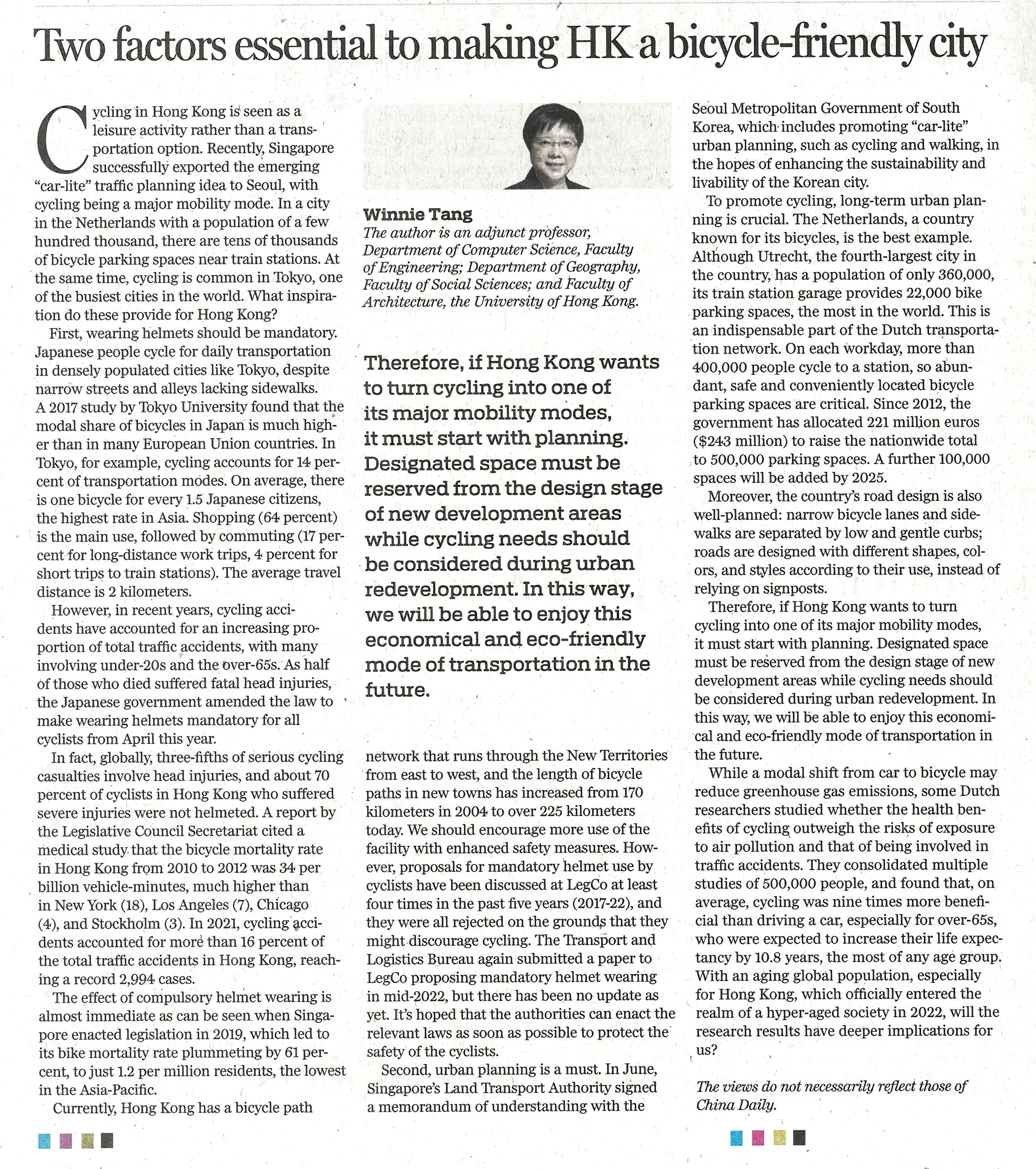網上版請按此

Two factors essential to making HK a bicycle-friendly city
Cycling in Hong Kong is seen as a leisure activity rather than a transportation option. Recently, Singapore successfully exported the emerging "car-lite" traffic planning idea to Seoul, with cycling being a major mobility mode. In a city in the Netherlands with a population of a few hundred thousand, there are tens of thousands of bicycle parking spaces near train stations. At the same time, cycling is common in Tokyo, one of the busiest cities in the world. What inspiration do these provide for Hong Kong?
First, wearing helmets should be mandatory. Japanese people cycle for daily transportation in densely populated cities like Tokyo, despite narrow streets and alleys lacking sidewalks. A2017 study by Tokyo University found that the modal share of bicycles in Japan is much higher than in many European Union countries. In Tokyo, for example, cycling accounts for 14 percent of transportation modes. On average, there is one bicycle for every 1.5 Japanese citizens, the highest rate in Asia. Shopping (64 percent) is the main use, followed by commuting (17 percent for long-distance work trips, 4 percent for short trips to train stations). The average travel distance is 2 kilometers.
However, in recent years, cycling accidents have accounted for an increasing proportion of total traffic accidents, with many involving under-20s and the over-65s. As half of those who died suffered fatal head injuries, the Japanese government-amended the law to make wearing helmets mandatory for all cyclists from April this year.
In fact, globally, three-fifths of serious cycling casualties involve head injuries, and about 70 percent of cyclists in Hong Kong who suffered severe injuries were not helmeted. A report by the Legislative Council Secretariat cited a medical study that the bicycle mortality rate in Hong Kong from 2010 to 2012 was 34 per billion vehicle-minutes, much higher than in New York (18), Los Angeles (7), Chicago (4), and Stockholm (3). In 2021, cycling accidents-accounted for more than 16 percent of the total traffic accidents in Hong Kong, reaching a record 2,994 cases.
The effect of compulsory helmet wearing is almost immediate as can be seen when Singapore enacted legislation in 2019, which led to its bike mortality rate plummeting by 61 percent, to just 1.2 per million residents, the lowest in the Asia-Pacific.
Currently, Hong Kong has a bicycle path network that runs through the New Territories from east to west, and the length of bicycle paths in new towns has increased from 170 kilometers in 2004 to over 225 kilometers today. We should encourage more use of the facility with enhanced safety measures. However, proposals for mandatory helmet use by cyclists have been discussed at LegCo at least four times in the past five years (2017-22), and they were all rejected on the grounds that they might discourage cycling. The Transport and Logistics Bureau again submitted a paper to LegCo proposing mandatory helmet wearing in mid-2022, but there has been no update as yet. It's hoped that the authorities can enact the relevant laws as soon as possible to protect the safety of the cyclists.
Second, urban planning is a must. In June, Singapore's Land Transport Authority signed a memorandum of understanding with the Seoul Metropolitan Government of South Korea, which includes promoting "car-lite" urban planning, such as cycling and walking, in the hopes of enhancing the sustainability and livability of the Korean city.
To promote cycling, long-term urban planning is crucial. The Netherlands, a country known for its bicycles, is the best example. Although Utrecht, the fourth-largest city in the country, has a population of only 360,000, its train station garage provides 22,000 bike parking spaces, the most in the world. This is an indispensable part of the Dutch transportation network. On each workday, more than 400,000 people cycle to a station, so abundant, safe and conveniently located bicycle parking spaces are critical. Since 2012, the government has allocated 221 million euros ($243 million) to raise the nationwide total to 500,000 parking spaces. A further 100,000 spaces will be added by 2025.
Moreover, the country's road design is also well-planned: narrow bicycle lanes and sidewalks are separated by low and gentle curbs; roads are designed with different shapes, colors, and styles according to their use, instead of relying on signposts.
Therefore, if Hong Kong wants to turn cycling into one of its major mobility modes, it must start with planning. Designated space must be reserved from the design stage of new development areas while cycling needs should be considered during urban redevelopment. In this way, we will be able to enjoy this economical and eco-friendly mode of transportation in the future.
While a modal shift from car to bicycle may reduce greenhouse gas emissions, some Dutch researchers-studied whether the health benefits of cycling outweigh the risks of exposure to air pollution and that of being involved in traffic accidents. They consolidated multiple studies of 500,000 people, and found that, on average, cycling was nine times more beneficial than driving a car, especially for over-65s, who were expected to increase their life expectancy by 10.8 years, the most of any age group. With an aging global population, especially for Hong Kong, which officially entered the realm of a hyper-aged society in 2022, will the research results have deeper implications for us?
Dr. Winnie Tang
Adjunct Professor, Department of Computer Science, Faculty of Engineering; Department of Geography, Faculty of Social Sciences; and Faculty of Architecture, The University of Hong Kong